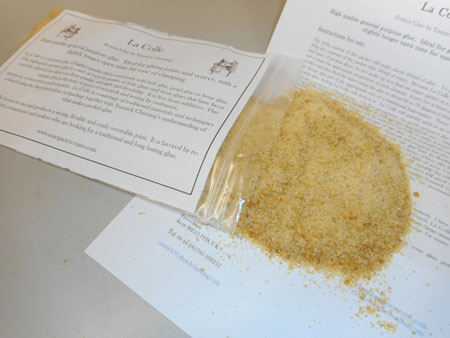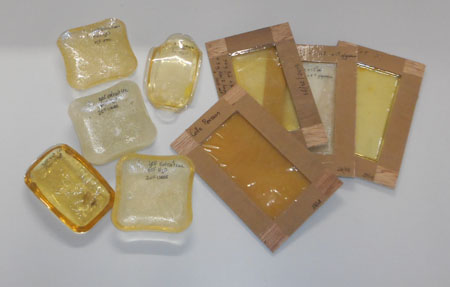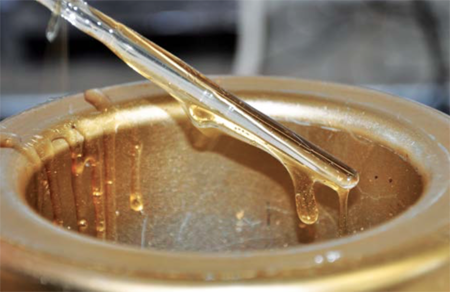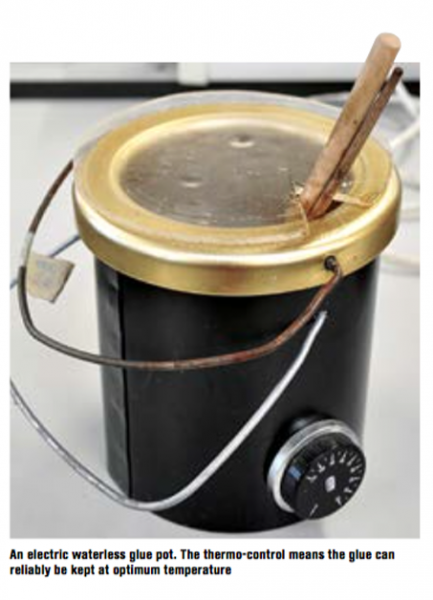La Colle, high quality protein glue (hide glue)
La Colle
New protein glue by Yannick Chastang:
High quality general purpose glue. Ideal for gluing joints and veneer.

La Colle is a superior glue of higher quality than commonly sold hide glue, pearl glue or bone glue. This high-grade protein glue is a mix of various grades of hide glues and bone glues that have been carefully selected for their excellent quality, strength and flexibility. It is free from additives. This unique glue is the fruit of years of research and testing by craftsmen, restorers, conservators and scientists. La Colle is a marriage of traditional materials and techniques refined using the latest hydrolysis technology together with Yannick Chastang’s understanding of what makes perfect glue.

Photo showing only a few of the many tests and samples carried out on commercially available glues
La Colle is easy to use and produces a strong, flexible and easily reversible joint. It is favored by restorers, conservator and makers who are looking for a traditional and long lasting glue.

Prices:
High quality general purpose glue. Ideal for gluing joints and veneer.
200g packet, including instructions: £ 15
(Prices do not include VAT and postage, please contact us by email for any order / quote)
Instructions for use:
The 200g content of this packet will make about 400ml of glue. To prepare La Colle, mix the entire 200g dry contents of the packet with 300ml of water. Because La Colle is a mixture of different grades and types of protein glues, do not make up less than an entire packet at a time as the resulting glue may not contain the appropriate proportion of each element. Leave for at least one hour. Once La Colle has swollen and absorbed the water warm the glue to about 60 to 70 degrees Celcius. (We recommend using an electric glue pot of the appropriate size or a traditional bain-marie). Never boil La Colle. Like any protein glue, boiling La Colle will destroy it. La Colle will quickly melt to an even and smooth liquid, with the consistency of liquid honey. On first preparation, the newly prepared glue may form a thin skin on top of the liquid and it is recommended to remove this skin before use. Depending on personal preference, a reasonable amount of water can be added to La Colle to make it more liquid and easier to work with, or make up with less water to make it easier to use for rub joint or hammer veneering. Too much liquid will alter the strength of the glue. For restoration/conservation, Yannick Chastang uses about 400ml of water instead of 300ml. Museum led research has also demonstrated that use of beer instead of water increases wetting properties of the glue and its flexibility. Half of the recommended water content can safely be replaced with the same volume of beer (the higher the alcohol content the better). Adding 3 to 5% of glycerin will also increase flexibility. Additionally, La Colle can be modified using 10-40% of urea. Urea will make La Colle more or less liquid at room temperature and as a result will not be suitable for rub joint gluing or hammer veneering. Joint or veneer gluing using La Colle modified with urea will need clamping for at least 12 hours. Too much urea will result in non-durable and poor glue quality; Yannick Chastang uses a maximum of 20% urea. For a protein glue, liquid at room temperature, we recommend La Colle Liquide.
If your glue does not work as expected, mail info@marquetrycentre.com for further advice.
Shelf Life:
In dry form, La Colle has an unlimited shelf life if stored in a dry and cool environment. Once prepared, shelf life is reduced to days or weeks depending on climate condition. Once prepared, La Colle should be stored in the fridge or freezer to extend shelf life. In Yannick Chastang’s workshop, large quantities of La Colle are prepared in advance and cast in small cakes that are stored in the fridge for many weeks. Do not use mouldy La Colle.
If never boiled, it can be re-heated many times. To avoid evaporation, cover your glue pot and occasionally add a little of water to compensate for any loss of water.
Precautions:
La Colle is a natural product. There are no risks attached to its use.
A quick explanation of glues:
La Colle and La Colle Liquide are protein glues which, depending on their origin, fall into the category of glues commonly known as hide glue, pearl glue or bone glue.
Hide, bone and skin glues
An animal glue is an adhesive that is created by prolonged boiling of animal tissue. All animal glues are collagen based which is a protein contained in animal bones and skins. The production of hide glue has always gone hand in hand with the tanning industries and is principally, in Europe, of cattle origin. Bone and skin glues are prepared from fresh or extracted bones and connective tissues essentially from cattle and pigs.
History of animal glue and woodworking
The earliest making of animal glue is recorded in ancient Egypt. Stone carvings depict glue preparation and use as early as 1500BC where it was used for wood furnishings, mural painting and for the Pharaoh’s tomb furniture. Although used by the Greeks and Romans, knowledge of the usefulness of animal glue died out in Europe until the 1400s when woodworking and furniture re-emerged as a craft. The first commercial glue factory began in Holland around 1700, manufacturing animal glue from hides. The use of animal glue in furniture making was at its height from the 1750s to the Second World War. Since then modern polyvinyl acetates (PVA) and aliphatics have been preferred. Today, animal glue is generally reserved to the restorer and conservator but demanding craftsmen value the numerous advantages of protein glues.
Disadvantages of animal glues
- Traditional protein glues, including La Colle can only be used warm and must be kept at a constant temperature of 60-70˚C. It is generally prepared in small batches in a bain-marie glue pot. La Colle Liquide is the only commercially available glue in the world that remains liquid at room temperature without the addition of unstable or dangerous chemicals.
- Animal glue is water-soluble and there are many projects to which it is simply not suited. British church furniture commonly suffered in the past because of the generally damp environments. Adding formaldehyde to the animal glue was common to increase its resistance to such damp environments. With modern drier houses and the health issues of using formaldehyde, it is not recommended to modify La Colle with formaldehyde. Protein glues are also hygroscopic (ie. it will take up and retain moisture) so are susceptible to changing atmospheric conditions and will react to the relative humidity of their environment. If the RH dips below 10% then the moisture content of the glue will lower and the glue will become brittle over long period of times. However, a gradual drying of an animal glue trapped between two pieces of wood may take centuries and protein glues are therefore regarded as very stable.
- Animal glue cannot be stored in a wet state. It needs to be made up in small batches and has a short shelf life. Storing small batches of glue in a fridge or freezer can extend the shelf life. Effectively it is gelatine, a food, and is subject to rotting and mould if not properly stored.
- It is no longer widely available. European demand for gelatine has fallen away drastically in recent years. In the drug industry pill capsules are now made of vegetable oil rather than gelatine and it is no longer widely used in the photographic and food industries. As the European gelatine industry has declined it has taken the production of glue with it and very few glue factories remain today. Sheppy Adhesives, established in Kent in 1887, has recently stopped producing glue, leaving no producers in the UK. Most animal pearl glues on the market come from developing countries such as China (see www.alibaba.com world suppliers) and it can be hard to ascertain the integrity of the method of manufacture or guarantee the quality of the glue offered for sale. Even if from a reputable source, the addition of preservatives (fungicides and bactericides) is almost inevitable. La Colle and La Colle Liquide are produced in Europe under very strict conditions, based on Yannick Chastang’s specifications.
Advantages of animal glue
- It is the only glue that is easily reversible using water and heat. Although this is not a priority for furniture manufacturers, for conservators, it is essential. Of course reversibility still has its uses in furniture manufacture either to correct a mistake or for the adjustment of prototype furniture. Protein glue is hygroscopic and thermoplastic (becomes soft when heated and hard when cooled) and gentle warming or application of warm water will release the joint.
- New animal glue can be happily mixed with old. Old animal glue will only degrade by dying out and loss of water content and if exposed to acid (very unlikely in most conditions). It can be regenerated or rehydrated by increasing the moisture content of the old glue. If the glue is excessively dry then new glue can easily be added on top of the old. In contrast, modern glues will degrade by cross-linking and cannot be salvaged. Considering that the furniture we make today may become the antiques of the future should not the reparability of the construction be as important as the design.
- It is the most stable and long lasting of all adhesives. Even objects made in the time of Tutankhamen can easily be reassembled, as the drying out of the glue has not affected the precious woodwork. Indeed, there are pieces of royal French furniture made by Riesener in the 1780s with very thin stable glue joints where the glue has not yet dried out. In most of the Riesener furniture I encounter the marquetry is still perfectly adhered to the wood carcass. It is movement in the 18th century solid wood carcasses that generally cause the problems, for example, a crack in a drop front caused by movement of the solid wood panel that has forced apart the decorative marquetry veneer.
- Protein glue is absolutely essential in pre-assembling marquetry on paper backing or when assembling veneer together prior to gluing on a piece of furniture. The ease with which any paper backing can be removed with water makes protein glue the favoured option. As opposed to modern tape and masking tape, the use of a little of water can easily remove the paper backing without any risk of pealing off the grain or the veneer. Residues of glue left behind can easily be washed away, as opposed to the sticky mess left by masking tape.
Using animal glue today
Are modern glues truly that much easier to use? Poor mixing of two-pack adhesives such as araldite often causes cross-linking and any small human errors in mixing will result in bad curing and fast degradation. Even though most manufacturers say their adhesives will last forever they have not passed the test of time and their claims are not proven. In my experience I have come across much PVA of the 1970s that is already degraded. All too often the glue no longer has any cohesion and strength but has become a rubbery mess stuck to the wood and that has to be laboriously manually removed with a scalpel. I regard with suspicion the manufacturers’ claims that the issues with the first generation of PVA products have now been resolved. It is a fact that furniture conservators are seeing increasing demand for restoration of 20th century pieces made of plywood, chipboard and modern adhesives. All these are proving almost impossible to restore compared to their much older counterparts.
Because durability of the glue is less of a priority than productivity in the modern furniture industry, animal glue and the attached inconvenience of keeping it warm has reduced the use of animal glue to only a few workshops. Liquid fish glue grew in popularity during the late 1970s as the traditionalist and restorers still needed a reversible glue, Only a handful of producers of liquid fish glue exist in the world and most commercially available fish glues are based on gelatine produced by Norland Products in America. Only fish skins and bones from deep-water fish have naturally the correct amount of natural acids to remain liquid at room temperature. Most fish glues sold in Europe are from Norland despite the numerous names and labels. Liquid fish glue is very convenient to use but has performed very badly in tests. Some additives, such as preservative agents and bulking agents are not only dangerous to health but dramatically increase the brittleness of the glue joint. One can also not fail to notice the many pots of liquid fish glue or liquid hide glue that have been left hanging around a workshop for 6 months or more that suspiciously do not develop any mould. For glue made of perishable ingredients, this raises questions about preservatives and additives, and the health risks these may present to its users.
Since the mid 1990s commercially produced cold animal glues have become available which have overcome many of the practical problems of use. These animal glues are traditional hide glues modified with chemicals to a liquid state so they can be used at room temperature. Most of the liquid cold glues on the market are a mix of protein glue and urea or thiourea. Thiourea is the most effective of the two but can be dangerous to health. Adding urea (peeing in the glue pot or adding horse urine) to protein glue is as old as the use of protein glue. It was extensively researched by a French group of conservators (led by the Musee Des Arts Decoratifs in Paris with the ADEN group) and a wood engineering school (ENSTIB) during the mid 1990s. Satisfactory results were achieved and manufacturers of protein glue like “the Old Brown Glue” have commercialized a version of urea modified glue based on these studies. With between 10 to 40% of urea or thiourea added to hide glue, the glues produced by Gorilla or The Old Brown Glue remains more or less liquid at room temperature. Whilst some modified protein glues have performed well in tests, these glues have a very short shelf life and the glue joint degrades faster over time. Additionally the quality of the raw hide glue chosen to be mixed with urea is often poor in order to save on cost.
If liquid fish glue and liquid hide glue have some obvious advantages but also many drawbacks, mainly durability, these glues also rely entirely on water evaporation to dry. As opposed to hot hide glue which will first harden when cooling down, followed by natural drying. Drying of the fish glue or liquid hide glue is very slow with the surrounding wood having to absorb the water.
However, conservators and some makers do favour protein glue liquid at room temperature. As a furniture conservator, liquid glue is very convenient to use. Over the past twenty years, Yannick Chastang and his colleagues have not stopped experimenting on new protein glues, but most serious conservators in the world have long stopped using liquid fish glue. In recent years, following a major breakthrough in hydrolysis of protein glue, a few gelatine manufacturers in the world have managed to produce protein glue of cattle origin that can be used at room temperature or lukewarm. For the first time, cattle hide glue, without the addition of any chemicals, is available for sale. Because of its cattle origin, flexibility is excellent and durability exceptional. It is the easiest glue to use. However, the refining process was developed for medical gelatines and remains very expensive. Yannick Chastang has sourced some of this cattle glue and is offering La Colle Liquide, ready to mix in water, in convenient quantities. This is a practical glue for restorers and makers who do not need the quick setting properties of hot hide glue but still value the use of a natural and reversible adhesive.
Tools to help your gluing
Up to now the biggest drawback against using animal glue has been the short open time. Heating the wood to extend the workability has always been desirable but not easy to achieve. Today’s solution is to cover the gluing with a thermo-controlled heating blanket. This flexible heating panel can be used in the veneer press, under clamps or simply placed on top of the gluing at the bench. They can easily be made using ready available silicone heated mats. Alternatively, infra red lights, widely and cheaply available can be used to warm up the surface, through the vacuum bags or before clamping (check first if your vacuum bag is heat resistant).
Another challenge is the glue pot to keep the glue warm. Traditional bain-maries are becoming hard to come across. The best traditional bain-maries were made of copper. The cheapest used to be made of cast iron. In both cases, the metal glue pot reacts with the glue and oxidizes, iron oxide from an iron glue pot being the worse of the two types. As an alternative to water filled bain-mairies, there are some electric glue pots available for sale (see the glue pots section on this web site). The best glue pots are from America but are very expensive, they are however the most durable and practical option in a commercial workshop.

Conclusion
Preparing and using animal glue might seem like a lot of fuss and hard work. For me, however, there is great satisfaction in knowing that my glue is designed to last. I know exactly what I have put in it and I am confident that it will endure longer than most of the modern glues around. I envisage each bespoke piece I make as an antique of the future and knowing that my furniture could easily be restored in two hundred years time is good news.